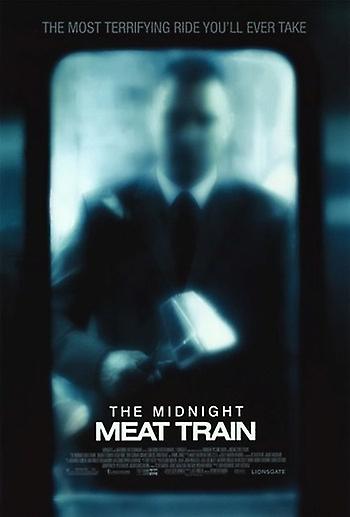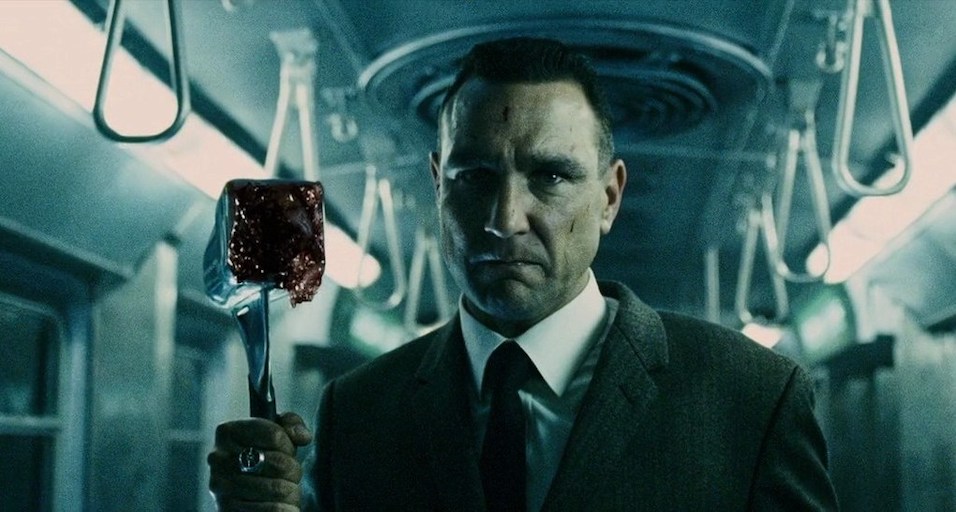Midnight Movies: Riding The Midnight Meat Train
In an early scene, time stops. The camera pulls back, locks, and you can’t help but become aware that the scene you’re watching is artificial. Leon (Bradley Cooper), the night-crawling photographer desperate for something, is camped out at the exit to a metro station. He watches as Mahogany (Vinnie Jones) silently rides the escalator, stops at the top and collects himself––a vast, still point of unresolved threat, a suit wrapped around barbarism. Mahogany looks around, the superb lighting by director Ryuhei Kitamura casting him as a buzzcut reaper, striding amongst the chaff.
It’s so over the top, so perfectly of its time, immediately skewing your perception of the film and its characters. Mahogany’s precision is as deeply unsettling as the comfort he offers Leon: answers, to who and what he is. It leads Leon further and further down the gristle-tinged rabbit hole. But we go with him, we’re invested because we know the journey is going to be weird and wrong and cool. We’re unable to look away, both wanting and not wanting to know what happens next.
Welcome to The Midnight Meat Train (2008), a film adaptation of Clive Barker’s short story of the same name, which encapsulates so much of why I think we love horror stories: the transition from the forbidden to coping mechanism.
Ryuhei Kitamura’s carefully unidentified city hums with the precise, cold confidence of being too busy to care about you. This is the exact same sort of city we see in plenty of horror movies, like Rosemary’s Baby and Abe Goldfarb and Mac Rogers’ The Horror at Gallery Kay (two movies that make for an excellent double-bill). Both explore this style of impersonal city-space and the desperate, personal stories that play out against its backdrop.

In Midnight Meat Train, the personal stories are frequently blood-soaked. Mahogany is a man of few words and violent action, and we see humans tenderized and dissected from nearly the start. Such splattery action is usually played for shock value or empty showmanship, but here it’s deliberate.
The violence carnival is interrupted by a member of the Guardian Angels, a non-profit volunteer crime de-escalation group formed in New York in 1979. It’s a moment of sudden cognitive dissonance, made deliberately more so by casting then-active mixed martial artist Quinton ‘Rampage’ Jackson in the role. He’s a larger-than-life figure playing a larger-than-life character fighting a larger-than-life antagonist (played by another crossover athlete, former footballer Vinnie Jones). The resulting post-modern fistfight almost melts the screen and, crucially, sets up the second half of the movie. This curious butcher is terrifying, but fallible, as we later discover.
The movie’s brand of cold, alien confidence writes a check its frankly ridiculous cast can absolutely cash. Brooke Shields’ cameo as predatory art dealer Susan Hoff feels like she’s walked in from a Sex and the City taping and is acutely aware which story is safer. Roger Bart as Leon’s doomed friend Jurgis has a charming, grounded outlook which lends the film some contrast. Character actors like Peter Jacobsen (of House and The Walking Dead universe) and Ted Raimi (Seaquest DSV in the house!) anchor tiny roles beautifully. Best of all, though, is the mighty Tony Curran––a man best known for roles as diverse as Vincent Van Gogh in Doctor Who to Gaines in Sons of Anarchy––as the train driver. You will never, EVER want to hear this man talk again. And you won’t be able to stop listening as he tells you what and who the train is really for.
Are there weak spots? Absolutely. You can start with the laughably awful treatment of the female characters. Shields and Barbara Eve Harris are excellent, but they’re in roles about as agency-filled as Kitamura’s beloved deserted stations. This is a movie where everyone is chattel, but the women are even more so. Leslie Bibb as Leon’s girlfriend Maya fares little better.
At its beating heart, The Midnight Meat Train is a movie about the intersection of photographer and subject, the art behind photography that never appears in the final photo. Jones’ Mahogany has almost no dialogue but carries pathos with the same weight as his bag of murder tools. Jones has rarely presented as overly large in his previous work, but here he’s the butler the Addams Family threw out for being too unsettling. There is something broken and wrong about Mahogany from the his first appearance on screen. Compare him with Bradley Cooper, a confounding, fascinating leading man. For every American Sniper there’s a Burnt. For every The Hangover, a Limitless.
Cooper excels when he works with contrast––clean-cut and raddled, goofy and desperately sad. Imagine Steve Rogers playing Frank Castle, or vice versa. Cooper’s Leon is a more polished, less likable version of Limitless’ Eddie. Possessing none of Eddie’s redeeming desire to do good, Leon just wants to be successful. Only, something is missing, not just from Leon’s work, but from Leon. He’s successful, handsome, settled, and… edgeless. Mahogany presents him with that edge by way of the impossible violence of the train. Leon can’t resist it precisely because he wants to best it, to be tested and emerge the victor. Faust with a camera, Leon signs the contract long before he knows the cost.
Leon becomes the stand-in for the viewer––our lens into the perception of the horror consumer. He wants to feel, to be challenged and pushed outside his comfort zone. His opening scene is as photographer, hiding from himself behind a camera. His final scene––tongueless, doomed to harvest a tithe older than civilization––shows him touching a photograph. Searching for a foundation? Mourning all he’s lost? All answers are equally valid. The space between ritual and art is paper thin, and both artist and observer are forever changed by their interaction. We learn what we can and can’t endure. We learn that there are styles and flavors of horror we enjoy or which bring us value. We learn what trains to catch and which to avoid.
Good art changes you. The simple, awful, cosmic truth at the heart of The Midnight Meat Train changes Leon forever. Our world is a thin skin drawn over an abyss; protecting the world from that reality becomes Leon’s penance, taking up the mantle of the classic horror protagonist and perpetuating the cycle of horror as transformation. Always searching for an answer. Never ready when they find it.
Be ready. And avoid the rails at midnight.
The Midnight Meat Train is available to rent or buy on Shudder, Apple, Amazon, YouTube, Google, and more.
This post was written for Nightfire in partnership with Pseudopod.




With all due respect, Rosemary’ Baby is almost obsessively a New York story. It works largely because New York—at the time—symbolized both the absolute order and wealth of Wall Street and the Upper West side and its opposite, the feared art chaos of Andy Warhol’s midtown and the counterculture downtown, Mia Farrow’s famed short hair style literally embodies this conflict of conservative fear and hatred against the counterculture disinterest in trad power structures. Clearly, the Devil just must be behind all these trad values threats.